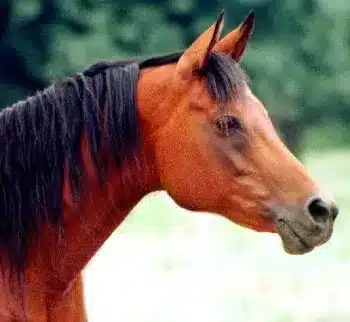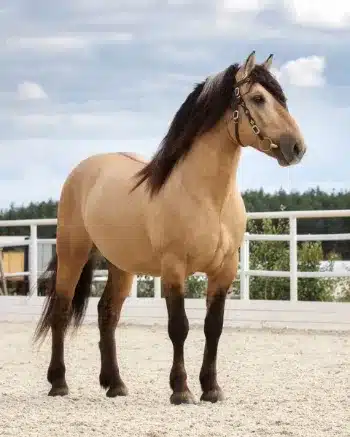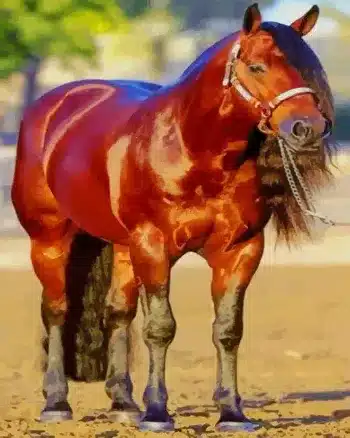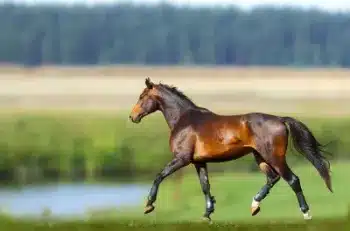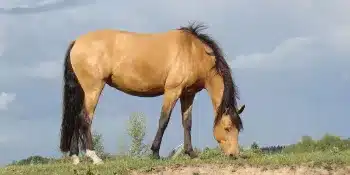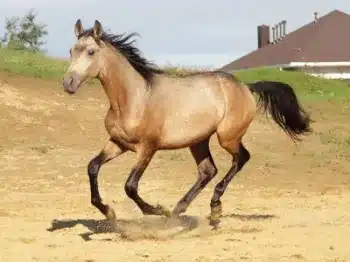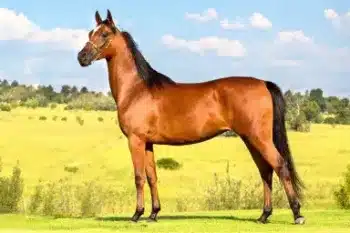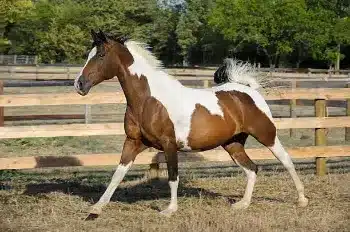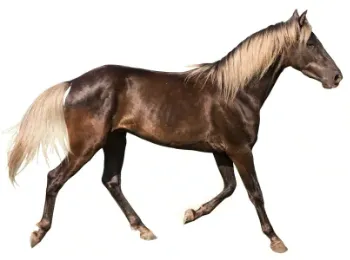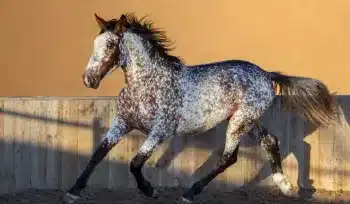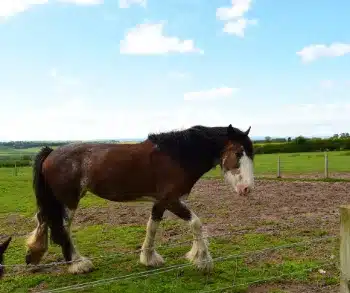Bay Horses: Colors, Genetics, Breeds, and Cost Explained
Bay horses are one of the most recognizable horse colors in the world. Their coats range from deep reddish-brown to mahogany, with distinctive black “points” on the mane, tail, ears, and lower legs.
To be considered a true Bay, a horse must have both:
-
A red-to-brown coat color
-
Black points (mane, tail, legs, ears)
This simple combination produces endless variations, from light golden bays to nearly black mahogany coats.
Interested in other colors? Check out:
Palomino Horses: The Golden Show Stoppers
| Variation | Coat Color | Genetics / Cause | Rarity | Notes |
|---|---|---|---|---|
| Copper Bay | Bright red-orange, penny-like | Standard Bay genetics (E + A) | Common | Lighter than typical Bay; often mistaken for Chestnut |
| Golden Bay (Light Bay) | Light red to golden brown | Standard Bay, lighter expression | Uncommon | Sometimes confused with Buckskin |
| Blood Bay | Deep red, mahogany tones | Same as Bay (Ee/AA), unknown modifier | Rare | One of the richest red shades of Bay |
| Dark Bay (Mahogany Bay) | Very dark brown with red undertones | Bay + strong red expression | Common | Can look almost black in low light |
| Buckskin Bay | Cream to yellow-gold body, black points | Bay + single cream dilution gene | Moderately rare | Classic “buttermilk” shade |
| Bay Dun | Yellowish body with black points & dorsal stripe | Bay + dun gene | Moderately rare | Dorsal stripe distinguishes from Buckskin |
| Wild Bay | Standard Bay coat, low black points | Bay + pangare gene | Uncommon | Black points stop below the knees/hocks |
| Bay Pinto | Bay coat with white patches | Bay + pinto spotting gene | Common | Also called Bay Paint horses |
| Silver Bay | Dark Bay body, light silver mane & tail | Bay + silver dilution gene | Rare | Striking contrast; highly prized |
| Roan Bay | Mix of red/brown and white hairs | Bay + roan gene | Moderately rare | Black points remain, body shows roaning |
The Genetics of a Bay Horse
Bay coloring comes from two key genes working together:
-
Extension gene (E) — creates black pigment.
-
Agouti gene (A) — tells the black pigment where to appear.
Together, they limit black pigment to specific “points” (mane, tail, legs, ears) while leaving the body a rich red-brown. This genetic combo makes Bay one of the most common (and most varied!) horse coat colors.
Shades and Variations of Bay
Bay horses aren’t just one shade of brown. Here are some of the most common types:
Copper Bay Horses - Bright, penny-colored coats with black points.
Golden Bay (Light Bay) Horse - Lighter red to golden coats, sometimes mistaken for Buckskins.
Blood Bay Horse Color - Rare, deep red coats with black points, often mistaken for mahogany.
Dark Bay (Mahogany Bay) Horse - Very dark, nearly brown-black body color.
Buckskin Bay Horses - Caused by a single cream dilution gene, producing buttery yellow coats with black points.
Bay Dun Horses - Similar to Buckskins but with a telltale dorsal stripe.
Wild Bay Horses - Black points that don’t extend far up the legs.
Bay Pinto Horse - Bay coat with distinctive white patches.
Silver Bay Horses - Brown coats with lighter silver mane and tail.
Roan Bay Horses - Mix of bay and white hairs, caused by the roan gene.
Breeds That Can (and Can’t) Be Bay
Never Bay (purebreds): Friesian, Haflinger, Suffolk Punch.
Commonly Bay:
-
Clydesdales (most common Bay draft breed)
-
Thoroughbreds
-
Quarter Horses
-
Tennessee Walking Horses
-
Arabians
-
Andalusians
Clydesdale Bay Horses
Bay Clydesdales are iconic. Known as “gentle giants,” they’re calm, intelligent, and trainable despite their massive size and heavy hooves. Bays are so common in this breed that many people picture a Bay horse when they picture a Clydesdale.
How Much Do Bay Horses Cost?
Bay coloring doesn’t change the price of a horse — breed, training, and age matter more.
-
Average horse price: $500 – $10,000+
-
Ownership costs: Feed, boarding, tack, vet, farrier, and transportation add up quickly.
If you’re considering buying a Bay horse, remember you’ll also need safe transportation. Explore custom horse trailers designed for comfort and safety.
Read more: Horse Ownership for Beginners: The Ultimate Guide for Beginner Horse Owners
FAQs About Bay Horses
What’s the difference between a Bay and a Brown horse?
Brown horses are uniformly brown; Bays have black points.
What colors look best on Bays?
Browns, taupes, coppers, and light pastels complement Bay coats.
What color are Bay foals born?
Usually dark, then they lighten into their Bay coat over time.
What’s the difference between a Bay Roan and a Red Roan?
Bay roans have black points; red roans have red points.
Is Bay a dominant gene?
Yes, Bay coloring is genetically dominant.
Key Takeaway
Bay horses are timeless, from fiery copper shades to nearly black mahogany tones. Their genetics make them one of the most common coat colors across popular breeds.
But whether you own a Bay or any other color, safe transport is essential. That’s why we design custom trailers that fit your horse’s size, temperament, and needs.
Want to learn more about horse care and safety? Grab our FREE resource: The Honest-to-Goodness Truth About Horse Trailers

